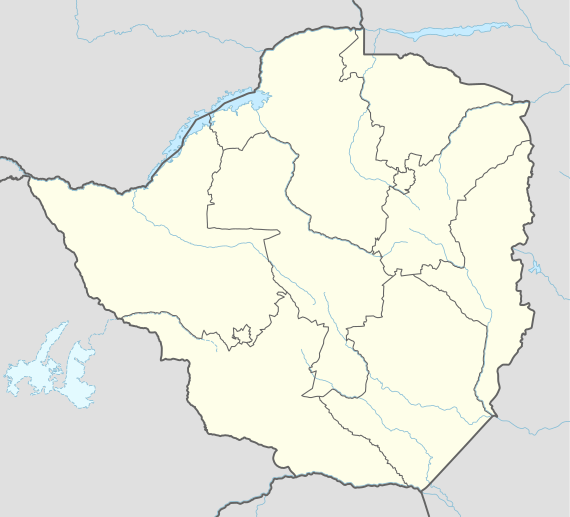Silobela
Silobela is an agricultural village in Kwekwe District in the Midlands Province of Zimbabwe. It is located about 60 kilometres (37 mi) west of Kwekwe town, 80 kilometres (50 mi) north-west of Gweru town, and bordering Nkayi on the west.
Silobela Silobela | |
|---|---|
Village | |
 Silobela Location in Zimbabwe | |
| Coordinates: 18.984258°S 29.299732°E | |
| Country | |
| Province | Midlands |
| District | Gweru |
| Time zone | UTC+2 (CAT) |
Background
Most of the inhabitants of Silobela were relocated from the area between Gweru and Bulawayo (called Hogo) in the 1940s to allow for white commercial farmers to take up that land. Most of the population is Ndebele and they speak the isiNdebele language.
Centers
A major centre in Silobela is the Loreto Mission which incorporates the Loreto High School, a Roman Catholic boarding school, the Loreto Hospital, which is the largest medical centre in the region, and the Police Station with detention cells. Also in the vicinity is an irrigation co-operative and a business centre with a supermarket, beer outlets and greengrocer's. The Gweru River passes just to the east of Loreto.
Crossroads District Service Center
Crossroads Growth Point is the commercial hub of Silobela. It is about 80 km Southwest of Kwekwe.[1] From this center one roads leads to Gweru, the other to Nkayi and the other to the northern villages of Silobela, and still the main one to Kwekwe, hence Crossroads.
Silobela Old People's Home
The Silobela Old people’s Home was built on a 20 hectare farm, which was donated by the Government in 1979.[2]
Villages
The district is divided into smaller undocumented areas each with several primary schools and fewer secondary schools. A non-exhaustive list of these smaller areas includes
- Grid 13, koMjika
- Lahleka,
- Nyakwathi,
- Donsa,
- Simana,
- Ntobe,
- Mtshogwe,
- Nzwananzi,
- Malisa, chief
- BB,
- Common range,
- Gobo,
- Ruya,
- Sinangeni,
- Sikhumbatshokotshe,
- Mahlathini,
- Kanye,
- Abifoil,
- Green,
- Jena Mines
- Zibomvu'
- Mtshikitsha'
- Mbombela
- KoParker
Economy
Silobela is known for its rich gold deposits. There have been reports of people finding exposed gold deposits in their back yards. Gold has been mined in the past by the now inoperative Turtle Mine, and by Empress Mine and Leopard Mine, now jointly known as Jena Mines. Currently, the Jena Mines, together with thousands of illegal gold panners, are actively extracting gold in the area. There is also Exchange Irrigation Scheme which is in Silobela Constituency and is administered by Silobela Offices yet geographically it is in Zhombe Communal Land.[3]
Jena Mine
Jena Mine is owned by the Zimbabwe Mining Development Corporation (ZMDC) which was established by an Act of Parliament No. 31 of 1982.
Jena Mine has seen both odd and even economic times but the ZMDC keeps resuscitating it.[4] Of late a new power line from the thermal Munyati Power Station has enhanced gold production at Jena Mine.[5] but local Solobela has not seen much improvements economically even though Jena Mine produces about 40 kg of gold each month.[6]
However, Jena Mine is the biggest gold producer in the Midlands Province employing over 600 people.[7]
See also
References
- Blessed Mhlanga|10 April 2013 — the cursed land of flowing riches|SILOBELA — Crossroads Growth Point, situated 80 km (50 mi) out of Kwekwe, is the commercial hub of mineral-rich Silobela constituency. NewsDay|National News|Retrieved 12 February 2016
- |Silobela Home of the Aged |The Silobela Old people’s Home was built on a 20 hectare farm, which was donated by the Government in 1979. Jairos Jiri Association website|Retrieved 12 February 2016
- Map of QueQue District|Sheet QK QueQue Final:(Exchange Dam is north of Silobela in Zhombe Communal land, then ZhombeTribal Trust Land).
- ZABA Opportunities in Zimbabwe| Specific exploitable brownfield gold mining operations that require recapitalization to restore profitability are as follows; a) Jena Gold Mine. It is located 100 km (62 mi) west of Kwekwe along the Nkayi in Silobela communal lands. The mine has an economic cut-off grade of 4, 26 grammes per ton, and the gold materialization occurs over a 6 km (4 mi) stretch. The mine is owned by the Zimbabwe Mining Development Corporation (ZMDC), and it requires US $15million for recapitalization. Zim-Angola Business Association|Mine|Gold|Retrieved 12 February 2016
- |Production at Jena Mine up 20% |Jena Mine has reported an increase in gold production from 40% to 60% following a $100 million capital injection into the construction of a power line from Munyati thermal power station.
- |Silobela — the cursed land of flowing riches|The dirty road leading to Jena Mine, owned by Zimbabwe Mining Development Corporation, makes a mockery of the wealth produced here (an average of 40 kg of gold every month) whose estimated value on the black market stands at a whopping $200 000
- Rumbidzai Zinyuke|28 January 2014 |BH24 » ZMDC seeks US$15 million to resuscitate Jena Gold Mines | Jena Mine is the biggest gold producer in the province and employs 632 people at full capacity. Bulawayo24|Business|Retrieved 12 February 2016